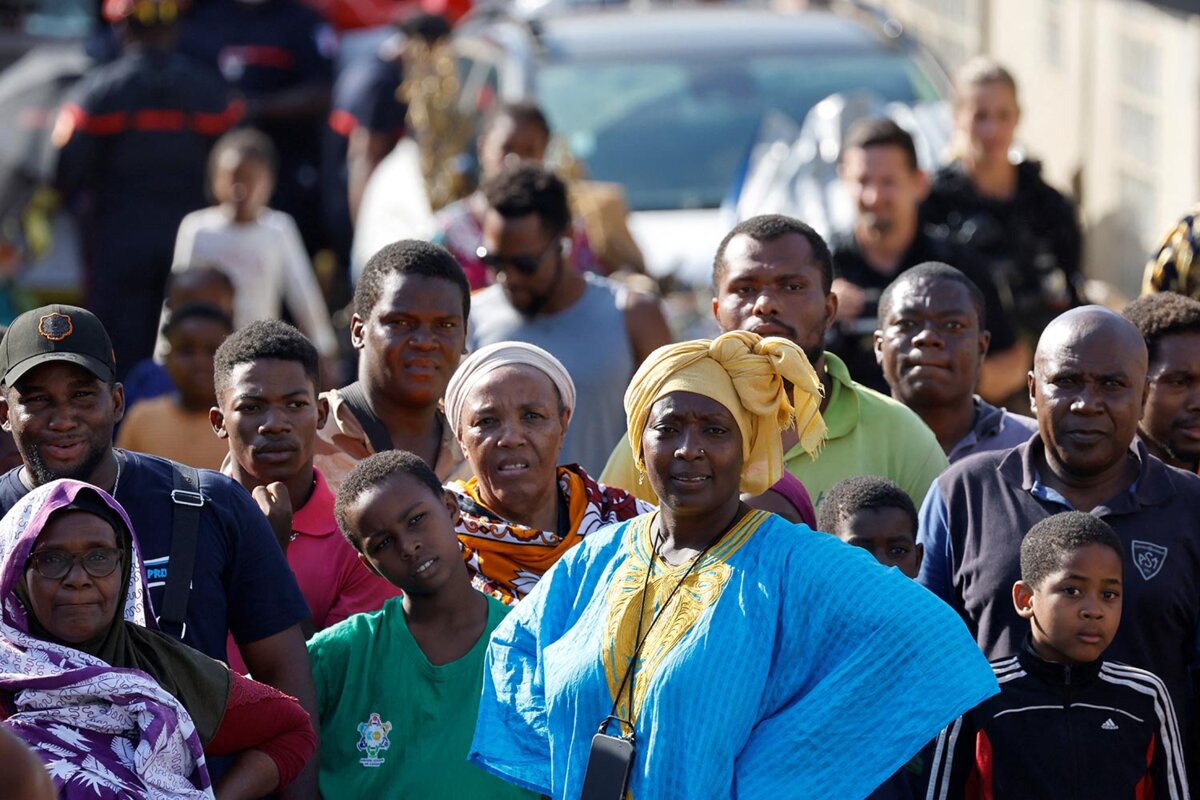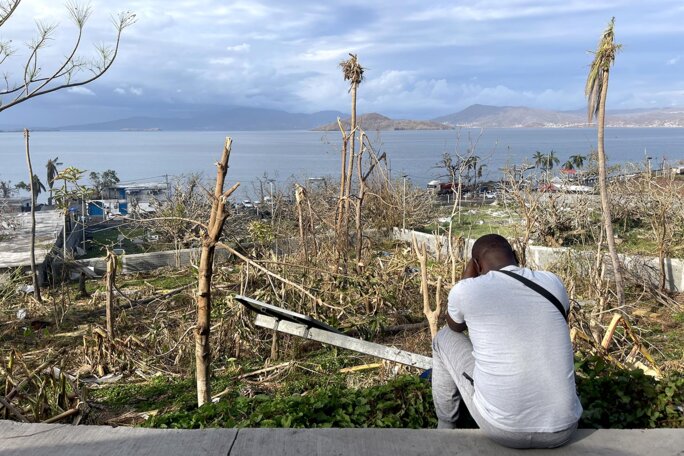Lucas, a physiotherapist, lives on Petite-Terre, the smallest of the two main islands that make up Mayotte, France’s Indian Ocean territory that was devastated on December 14th by Cyclone Chido. One of the major consequences of its passage has been a dire shortage of drinking water, electricity and food supplies. In the courtyard of the apartment building where Lucas lives there are water taps, which for the past six days remained dry. Lucas made one more try on Thursday, and the water began flowing at last.
After filling his can, he knocked on the doors of neighbours in the town of Labattoir to let them know. One of them, Moussa, went down to place a ten-litre can under a tap and rushed off to find empty plastic bottles. Moussa’s home was largely demolished by the cyclone, when he lost most of his belongings.
He lives beside a few mattresses and a fridge, his family’s clothes in a plastic container. As soon as dawn rises, he seeks out the debris of pieces of corrugated iron that have been ripped out and scattered by the cyclone and, hammer and nails at hand, attempts to rebuild his home. “The sound of hammers on iron are the rhythm of our days since Saturday [December 14th],” said Lucas, who has been helping his neighbours re-erect their fragile homes.
Lucas co-rents his apartment with Ginebra, who has taken on the role of local nurse since last weekend. “People cut themselves handling the corrugated iron,” she said. “They have wounds to their feet from walking [with the metal sheets], or on their arms while rebuilding their shacks. They know we have at home what’s needed to treat them.”

Enlargement : Illustration 1

In Labattoir, like across almost all of Mayotte, the winds of the Cyclone reached close to 230 kilometres per hour, pummelling to the ground everything they passed over. What were once areas of luxuriant vegetation were turned into flatlands of bare soil. Just a few palm trees, their branches pointing downwards, are still standing. The fences and gates that once hid habitations have gone, and a mixture of tree branches, metal and other debris litter the sides of the roads that have been cleared for vehicles.
Lucie Deglise is a speech therapist based in Kawéni, on the main island of Grande-Terre, close to the site of the island’s largest shanty town. Her apartment is a modern construction but did not resist the power of the cyclone. “I’ve the impression of being in Haiti, I recall the images of an island devastated by an earthquake,” she said. “But this is my home.”
“The ceiling of my living room collapsed. I panicked, I told myself that that of my bedroom would fall as well. I hid under my bed, but water started coming in. There was almost ten centimetres on the floor. I couldn’t stay there, I said to myself I was going to drown.” She eventually placed herself in her large wardrobe.” “It must have lasted two hours,” she recalled tearfully, adding that she thought she would die. Once the worst of the cyclone had passed, she found refuge with neighbours.
Only those with legal status are allowed rations
After Chido left Mayotte to continue its devastating path north-west, life on the archipelago is in suspension. The priority for most is to find water and food, and the threat of diseases spreading from the drinking of dirty water is a serious concern. According to the local authorities, 50% of water supplies will soon be re-established, and 95% will be back on track within seven days. But such promises appear difficult to envisage given the extent of the chaos all around.
Some inhabitants are able to scavenge fruit that fell to the ground during the cyclone, but the food shortage is becoming acute. Distribution of rations has begun on Petite-Terre, but they are strictly reserved for those who have legal status. “You need an identity card to pick up a food parcel,” explained Laura, a teacher.
Mayotte, despite being France’s poorest département (county), has long been a magnet for migrants, notably from the nearby Comoro Islands where poverty is widespread, and the issue of illegal immigration has, aside of this extreme natural disaster, become top of the political agenda. Most of those who entered Mayotte illegally live in notorious shantytowns.
Laura said that what the rations contain is minimal. “We had tins of sardines, cans of tuna, raviolis and two bottles of water per household. I live alone, but for families with six children it’s a bit tight.”

Enlargement : Illustration 2

The authorities have announced the sending of 20 tonnes of food to Petite-Terre, which equates to around 1 kilo per person for the 30,000 inhabitants of the island. With aide restricted to those with legal status, the supplies are “not for those most in need”, commented local resident Léo Biso, referring to the large community of illegal immigrants.
Just one supermarket is open on the island, and on Thursday a queue had begun forming before it opened at 8am. “The queues at supermarkets are interminable,” said Yousra, who had been lining up for twenty minutes. “They let people in bit by bit.”
Customers can only pay for goods in cash, because the credit card network was downed by the cyclone. Out of 72 cash withdrawal machines on Mayotte, just seven remain working, and all of them are situated in Mamoudzou, the archipelago’s main town. Meanwhile, 80% of the mobile phone network is down.
According to the interior ministry, a fresh round of food and water supplies are due to reach Mayotte this weekend. “All the food we had is no good since the cyclone,” said Abdoul, sitting on the steps to his neighbour’s house, close the debris of his own home on Petite-Terre. “We help each other, but in three, four days we’ll have nothing, and no-one comes to help us.”
The unknown situation in the shantytowns
The death toll so far registered by the French interior ministry is 31, but the authorities themselves believe the true toll may well be far greater. “We heard that the police who flew over Mayotte discovered shantytowns that were almost deserted,” said Ginebra. Just 10,000 people used the emergency shelters during the cyclone, whereas the local authorities had identified 100,000 people living in “vulnerable habitations”.
On his arrival in Mayotte on Thursday morning, Emmanuel Macron was met by Estelle Youssouffa, a centrist Member of Parliament. “We have a clandestine [immigrant] population which is now buried under the rubble, under the corrugated iron in the shantytowns that have been razed to the ground,” she told the French president. “Really?” he asked. Youssouffa told him that “no-one has been able to go the razed zones”, her comments confirmed by the local prefect, François-Xavier Bieuville. Speaking before the media, he said: “In all the informal quarters [shantytowns], for the moment we have not yet gone up there for reasons of urgency on vital things.” Yet the largest shantytown lies on the outskirts of Mamoudzou at Kawéni, which is accessible by foot.
In such conditions, reaching a true death toll will be some time off. “The people who are deceased are often buried in the day, close their banga [hut], as Muslim tradition demands,” said Léo Biso, from Peite-Terre.
A local civil servant speaking on condition his name was withheld, spoke of further difficulties ahead. “The rainy season will arrive, everything will be carried away, the misery will be even greater and it is a health crisis that lies in front of us. His fear is that “the rainwaters carry away decomposing corpses and that diseases will spread”.
Shortly before Macron’s arrival on Thursday, heavy rain fell over the archipelago.
Mediapart met with Johanna, a secondary school teacher, as she tried to find a mobile connection close to the airport on Grande-Terre to put in a request for repatriation. “If there’s nothing to eat or drink within a few days from now, I fear the worst,” she said. “We’ve already begun being [robbed], and that will not get any better.”
The civil servant previously cited warned: “Those people who no longer have a ‘banga’ [makeshift shack] have nothing to lose. And they want to survive.”
-------------------------
- The original French version of this report can be found here.
This abridged version in English by Graham Tearse


